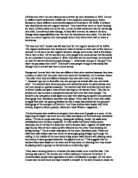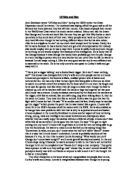The bunkhouses were small and cramped; there were over 5 people to a room. At the beginning of chapter two there is a very clear description of the bunkhouse. Steinbeck writes, "The bunk-house was a long, rectangular building. Inside, the walls were whitewashed and the floor unpainted. In three walls there were small, square windows, and in the fourth a solid door with a wooden latch. Against the walls were eight bunks, five of them made up with blankets and the other three showing the burlap ticking." This is a clear description of the room. Steinbeck adds, "Near one wall there was a black cast-iron stove, its stove pipe going straight up through the ceiling. In the middle of the room stood a big square table littered with playing-cards, and around it were grouped boxes for the players to sit on." This suggests that the workers lives were based on the ranch and if they were not working then they would be playing cards or going to a whorehouse on a Saturday night.
There was a ranking system in America that was similar to an unwritten law. This ranking was used on the ranches and unfortunately put Crooks at the bottom. In America black people were oppressed and were not allowed to prosper. On the ranch Crooks had his own bunk and kept himself to himself. In the story Crooks is inside his bunk, Lennie and Candy come to visit him because the other men have gone to the whorehouses for the night. Curley's wife is lonely so she comes to Crooks' bunk for some company. Unexpectedly Curley's wife enters the room, she disguises her need to be around people and asks "Any you boys seen Curley?" but Crooks and Curley rudely welcome her and says, "Curley ain't been here." She defensively calls them the weakest of the bunch. Crooks rises up to his feet and tells her to get out, but Curley's wife calls him a nigger and threatens him. She claims that she can arrange for him to be lynched and says, "Well you keep your place, then Nigger. I could get you strung up so easy it ain't funny." Crooks becomes silent again and sits down on his bed. This shows how Crooks was easily discouraged by a white woman and how he hardly had any rights. Crooks is clearly one of the most intelligent on the ranch but is oppressed by the hierarchy of America and the ranch.
For most people who were affected by the Wall Street Crash were motivated by the American Dream. It was the dream that they could have the chance to excel and work for themselves and that they would be successful in whatever they do. "Of Mice and Men" shows this in George and Lennie's dream of owning their own farm and living off their land. George describes their dream to Lennie because he forgets. George says, O.K. Some day-we're gonna get the jack together and were gonna have a little house and a couple of acres an' a cow and some pigs and-." Lennie interrupts and says, "An' live off the fatta the lan'." This was even popular around the whole world. People would move to America from places like China, Russia, Italy and many more places, to own businesses like food restaurants, but some of them ended up doing organized crime and living on the dangerous streets. The story shows that the dream was popular, when Lennie let the secret of the dream slip out, Candy is quick to consider and joining and explains to George how he can help with his savings. Candy says, "I ain't much good with on'y one hand. I lost my right hand here on this ranch. That's why they give me a job swampin'. An' they give me two hundred an' fifty dollars 'cause I los' my hand. An' I got fifty more saved up right in the bank, and I got fifty more comin' the enda the month. Tell you what-' He leaned forward eagerly. 'S'spose I went in with you guys. Tha's three hundred an' fifty bucks I'd put in. I ain't much good, but I could cook and tend the chickens and hoe the garden some. How'd that be?" This shows how Candy is willing to join George and Lennie's dream and bargains with them.
In the 1930's Hollywood was an industry that was growing rapidly. Young girls would dream of becoming actors and musicians. Their heroines would be famous stars female stars. Some women and teenagers would spend most of their lives preparing for a career in Hollywood. Producers and talent spotters would spend travel and search for potential stars and actors. Some people would pretend and take advantage of the women; they would tell the women how they could make them famous and use them. The story mentions this using Curley's wife when she tells Lennie how she could have become a famous Hollywood film star. Curley's wife tells Lennie and her chance to become a film star and says, "Well, a show come through, an' I met one of the actors. He says I could go with that show. But my ol' lady wouldn' let me. She says I coulda. If I'd went, I wouldn't be livin' like this, you bet."
"Of Mice and Men" is an excellent reference for information on the 1930's. It helps us to understand what was happening in the 1930's. It gives us a clear idea of white people's attitude towards black people and everyone's attitude towards The Great Depression. This story is a very good reference of oppression in the 1930's. Candy describes the bosses' behavior to George and says; I guess the boss'll be out here in a minute. He was sure burned when you wasn't here this morning. Come right in when we was eatin' breakfast and says, 'Where the hell's them new men?' An' he give the stable buck hell, too." This shows how even though Crooks' work was good and that even though he was much liked around the ranch he did not seem to be much appreciated. The 1930's were a very hard period for black people and women of all colours. I think that "Of Mice and Men" is an excellent source for information on the 1930's.
By Rachel Barrios








